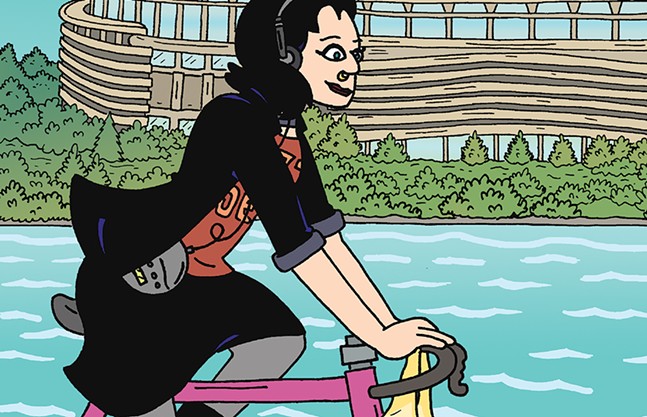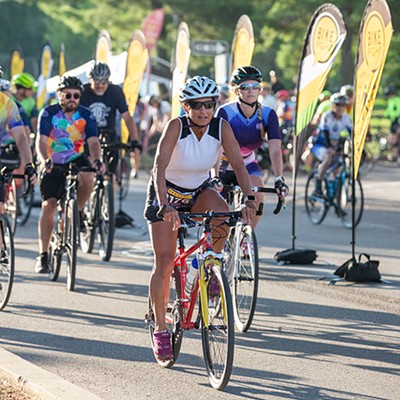Today’s Pittsburgh is pretty good for cyclists. There are trails, protected bikes lanes, streets with traffic-calming designs that make it easier to share the roads with cars. Between 2010 and 2016, Pittsburgh nearly doubled the number of its bike commuters, adding 1,260 cyclists.
It’s not perfect (no city is), but it’s miles better than it was 25 years ago.
Becky Mingo should know. She was a bike commuter back then, and she is still riding today.
Mingo helped start the PedalPGH bike festival, then called Pedal Pittsburgh, in 1994. The festival is a tour through several Pittsburgh neighborhoods. She also served on its board from 1999-2004, when it was run by Community Design Center of Pittsburgh. The event is now run by cycling-advocacy group BikePGH.
She moved to Pittsburgh in 1986 for school, and she would get some looks from passersby while pedaling through city streets.
“When I first moved here, and rode my bike downtown, people were aghast,” Mingo says with a laugh. “Before, you felt like you almost knew everyone who bikes in the city. Even though people had [bikes] in their garages, they just didn’t ride them on street.”
She says the ascendance of American bike racers such as Greg LeMond led to more cyclists on streets. But they weren’t bike commuters. They weren’t using a bike to get to work, school, or restaurants.
However, cycling’s growing popularity helped give Pedal Pittsburgh organizers the idea to start the bike tour.
“There was this huge sweep where people put on their tight pants and shirts and get on their bikes. The idea of Pedal Pittsburgh was sort of the opposite to that,” says Mingo. “People could ride in their neighborhood and go to other neighborhoods.”
It was the embrace of the leisure of biking that built the tour. Cyclists can stop and exit streets with ease, so enjoying the view or talking to a friend is possible on bike, while difficult in a car. Pedal Pittsburgh was about capitalizing on this advantage.
“And the biking, it was about getting out there and rebuilding relationships, neighborhood to neighborhood,” she says.
Those ideas from the early Pedal Pittsburgh events have influenced modern Pittsburgh biking culture. Mingo loves how Ellsworth Avenue in Shadyside has become a de facto bike boulevard, where bikes make up a large chunk of the morning commute. She says it makes the entire area more pleasant.
Pittsburgh has progressed so much since the early days of bike commuting. Where Mingo used to always say hello to every cyclist she saw (there weren’t many), now she has to, at times, just keep her head down and ride.
“Sometimes I feel like I am part of long railroad car of bikes and love it,” says Mingo. “It has just changed so much.”
PedalPGH, Sun, Aug. 26, start times range from 7-10 a.m. Southside Riverfront Park, 1 S. 18th St., Southside. pedalpgh.org
Drivers should be thanking cyclists, not cursing them
Think about that moment when you're behind the wheel, and you encounter a cyclist. Your instinct tells you to get annoyed, maybe honk, maybe follow too close, maybe swerve around and shout obscenities. It’s simple right? A bike in your way means a longer commute.
And while that cyclist might add three or four seconds to your drive (gasp!), in the long run, the bike rider is actually making your commute shorter. A bike rider without a bike is likely also a motorist. The vast majority of Bike Pittsburgh members own cars. If they weren't biking, they might be driving. So, more bikes means fewer cars on the roads, which means less traffic, since cars take up much more space than bikes. It’s that simple.
And I’m not speaking nonsense. It’s scientifically proven. Especially when cities provide that thing Pittsburgh drivers seem to hate the most: bike lanes.
Studies show a protected bike lane in New York City decreased cars’ travel time from 4.5 minutes to 3 minutes along a 20-block stretch. News-data site FiveThirtyEight found that despite the same amount of car traffic on select roads in Minneapolis, traffic congestion stayed the same even after bike lanes replaced car lanes.
So drivers, don’t curse cyclists. Give them a thumbs up!

















